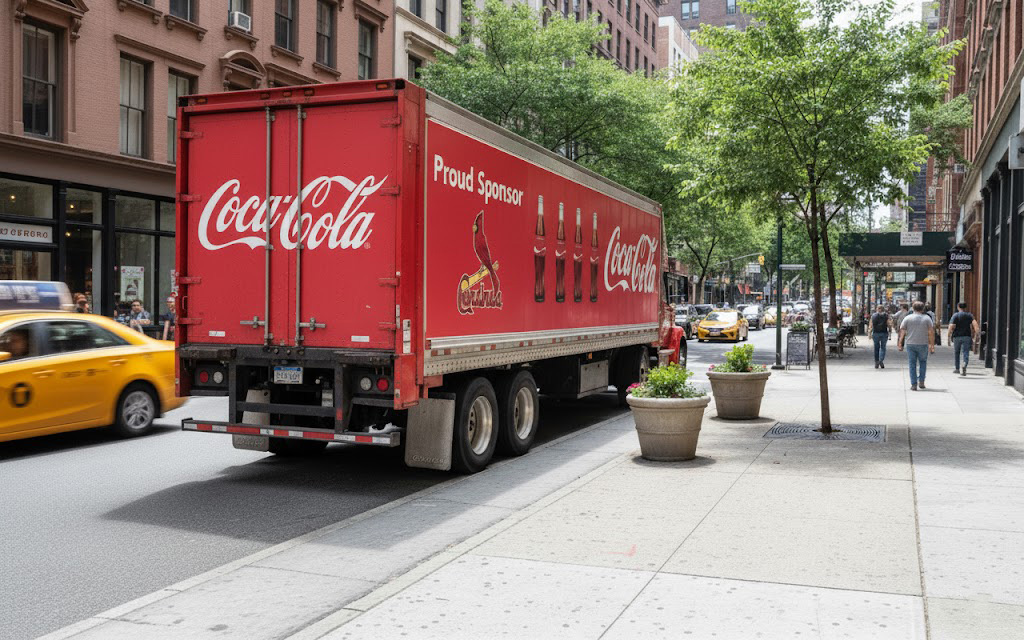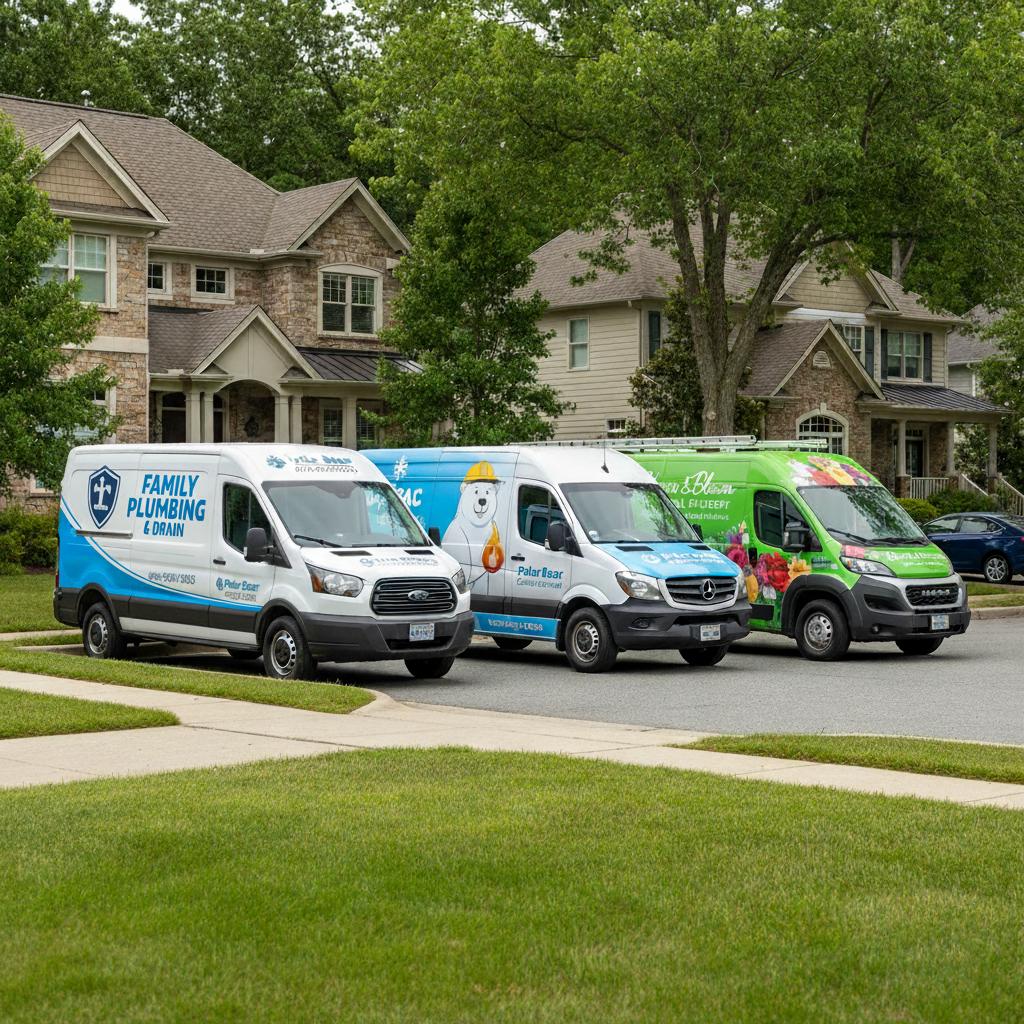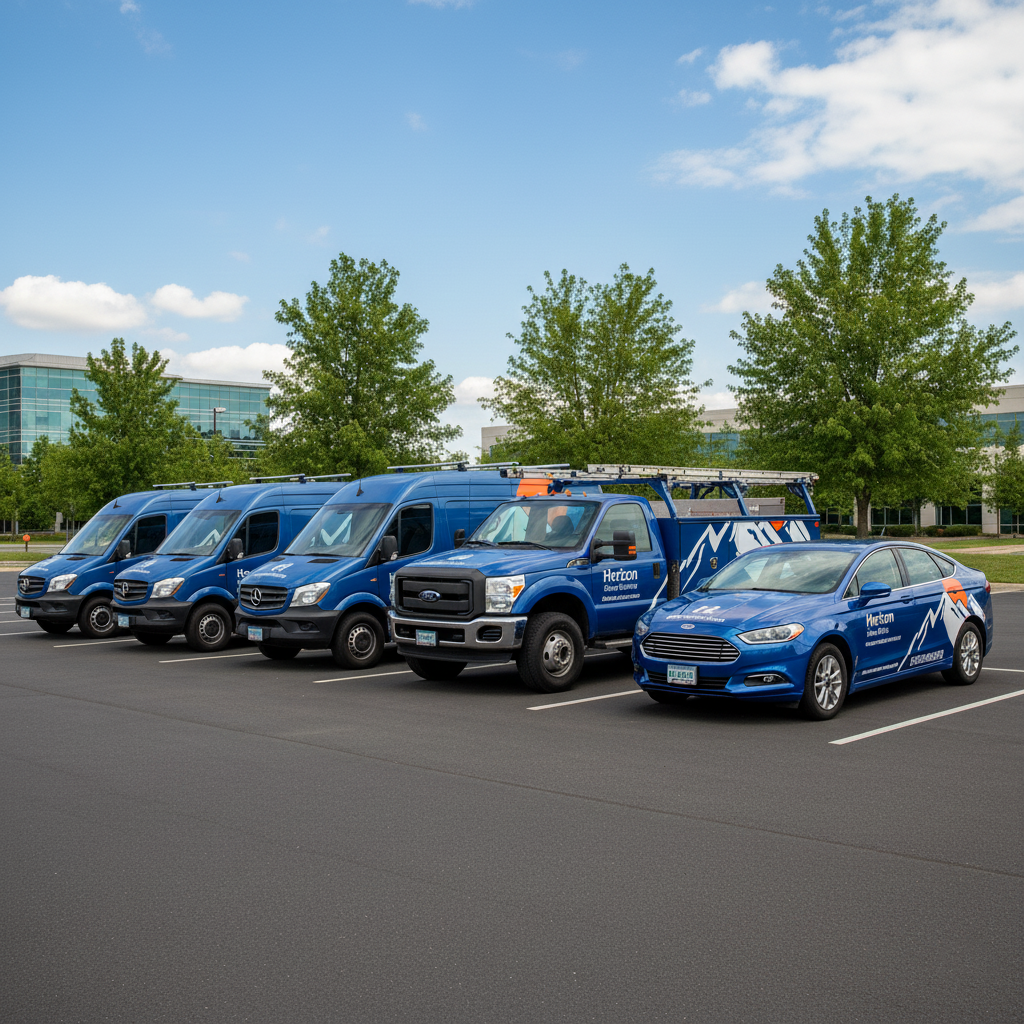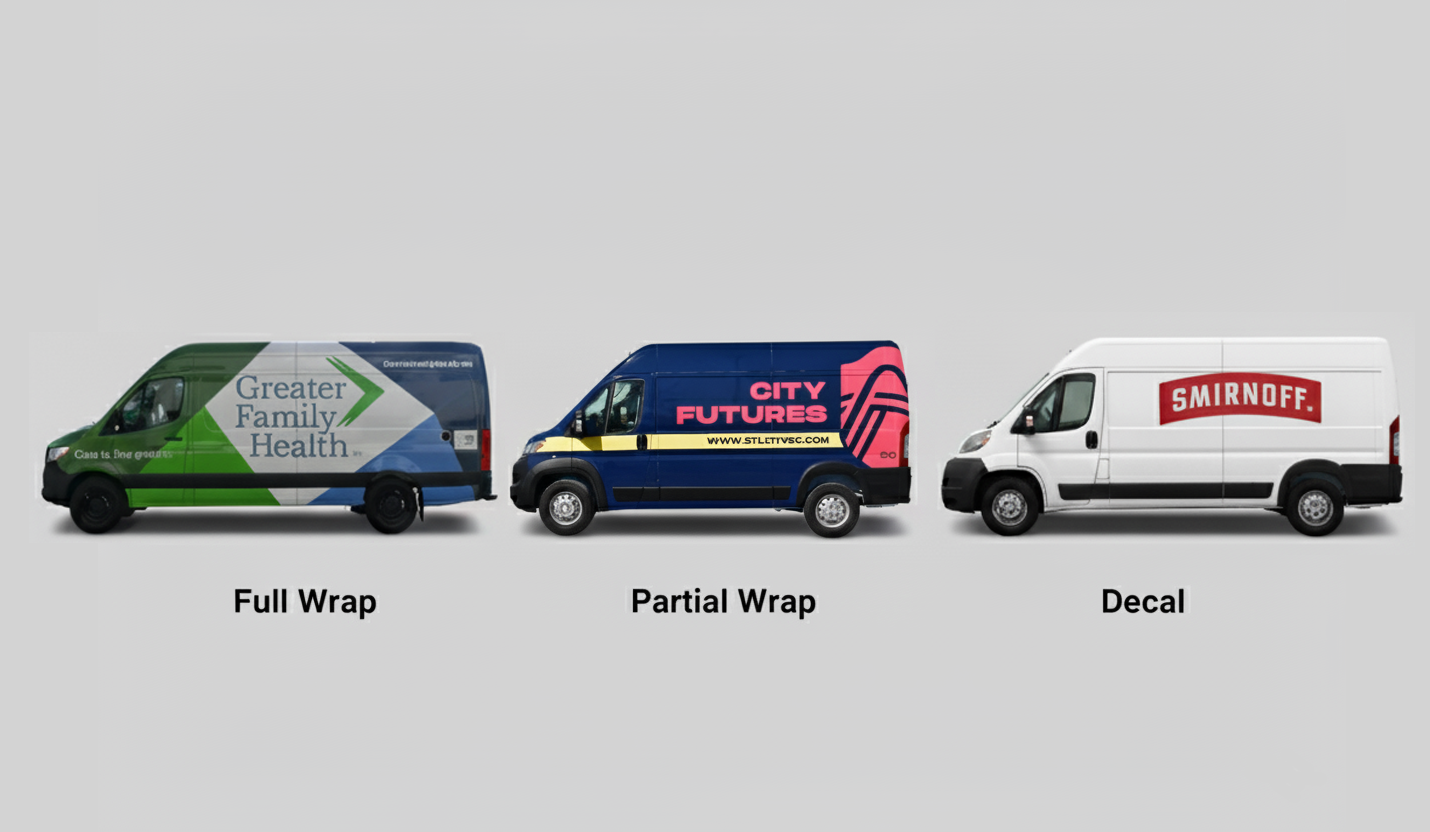Case Studies: How Fleet Graphics Drive Brand Impressions
Fleet graphics are high-quality vinyl wraps or decals applied to company vehicles, turning everyday trucks, vans, or cars into powerful mobile...
10 min read
Craftsmen Industries Oct 20, 2025 6:35:59 AM

Fleet graphics are one of the most effective yet often overlooked ways to increase brand visibility. In simple terms, they are vinyl wraps, decals, or branded designs applied to company vehicles, transforming everyday cars, vans, or trucks into mobile billboards. Instead of relying solely on static signage or digital ads, businesses can use their existing fleets to deliver consistent brand exposure across entire cities.
The impact is far greater than most people realize. A single vehicle wrap can generate up to 70,000 daily impressions depending on traffic and location. This means that even a modest fleet can collectively deliver millions of brand views each month, often at a fraction of the cost of traditional advertising. Unlike digital campaigns that require ongoing budgets, fleet graphics are a one-time investment.
This guide explores everything you need to know about leveraging fleet graphics for maximum brand visibility. From understanding the benefits and design considerations to evaluating costs, measuring ROI, and staying compliant with local regulations, you’ll find a comprehensive breakdown of how to make the most of this powerful marketing tool.
Fleet graphics are professionally designed vinyl images, lettering, or wraps applied to company vehicles to promote a brand while the vehicles are in operation. They transform cars, vans, trucks, and even buses into moving advertisements, ensuring the business logo, colors, and message are consistently visible to potential customers. Unlike temporary stickers, fleet graphics are made from durable vinyl designed to withstand weather, washing, and long-term use.
There are several types of fleet graphics, each offering different levels of coverage and impact:
From small decals on service cars to bold full wraps on nationwide delivery fleets, fleet graphics are a versatile way to make every vehicle a marketing tool.
Fleet graphics are more than just decoration; they're one of the most powerful tools for consistent brand exposure. A single wrapped vehicle can generate 40,000 to 70,000 daily impressions, depending on traffic density and location. When comparing costs, the advantage becomes even clearer: fleet graphics average around $0.48 per thousand impressions (CPM), while traditional billboards often cost $3.56 per thousand impressions.
This makes fleet branding not only high-impact but also cost-efficient, delivering long-term exposure for a one-time investment. Beyond numbers, the psychological effects of fleet graphics play a key role in marketing success. Studies show that repeated visual exposure strengthens brand recall, making customers more likely to remember your business when they need a product or service.
A clearly branded fleet also communicates credibility and trustworthiness. People are more comfortable opening their doors to a plumber, electrician, or delivery driver who arrives in a well-marked vehicle than one in an unmarked car. Over time, these small but consistent impressions create stronger associations with reliability and professionalism.
Fleet graphics combine measurable reach with intangible trust-building. They not only get your logo seen by thousands each day but also create a psychological anchor in the minds of potential customers, helping your brand stand out in competitive markets.
Fleet graphics aren’t one-size-fits-all; businesses can choose from a range of options depending on budget, desired impact, and branding goals. From subtle decals to bold full wraps, each type offers unique advantages. Understanding the main categories helps companies pick the right solution for their fleet and marketing strategy.

A full vehicle wrap covers nearly every visible part of the vehicle, including doors, side panels, hood, rear, and often windows, with perforated vinyl that allows visibility from the inside. This creates a seamless look that turns a car, van, truck, or bus into a moving billboard. Due to their large surface area, full wraps can feature vibrant colors, high-resolution images, and bold messages that are impossible to miss on the road.
The investment for a full wrap typically ranges from $2,500 to $5,000 per vehicle, depending on size and complexity. While this may seem high, it provides years of exposure with no recurring costs, making it one of the most cost-effective forms of advertising. Vehicle wraps can last up to seven years when properly maintained, offering long-term value.
Partial vehicle wraps cover specific sections of a vehicle, such as half of the sides, rear panels, or the hood. Designers often blend the wrap seamlessly with the vehicle’s base color, creating an impactful look at a lower cost. This option offers strong branding while leaving certain parts of the vehicle exposed, making it a versatile choice for businesses with tighter budgets.
The price typically ranges from $1,000 to $3,000 per vehicle, which is significantly cheaper than a full wrap while still generating thousands of daily impressions. For example, a local HVAC company might place large images of its equipment on the sides of vans, while leaving the roof and front areas unwrapped.
Well-designed fleet graphics are highly effective in driving local awareness, especially for service businesses that depend on repeat exposure in neighborhoods.
Spot graphics (or decals) are smaller vinyl elements placed strategically on vehicles. These can include a company’s logo, website, phone number, or tagline, often installed on doors, hoods, or windows. They are the most budget-friendly fleet branding option, with costs starting at just a few hundred dollars per vehicle.
Although they don’t offer the same visual dominance as wraps, decals are still highly effective for creating recognition. A cleaning service, for instance, might add a large logo on the side doors and contact information on the rear windshield to ensure visibility in traffic. Because they are easy to install and replace, decals are also ideal for seasonal promotions or updating brand messages without requiring a complete wrap replacement.
Reflective graphics are designed to improve safety and visibility, particularly for fleets that operate at night or in low-light environments. Made from reflective vinyl, these graphics illuminate when hit by headlights, ensuring that vehicles remain noticeable after dark. This is especially valuable for logistics companies, emergency services, or utility providers working overnight shifts.
In addition to safety benefits, reflective graphics continue to promote branding 24/7, reinforcing visibility even when most traditional ads are unseen. Specialty finishes, such as matte, chrome, or metallic vinyl, can also be used to create a premium look that helps a business stand out from its competitors.
For companies that prioritize safety compliance, reflective materials are often recommended by organizations such as the Federal Motor Carrier Safety Administration (FMCSA), which emphasizes the importance of visibility in reducing nighttime accidents.
The effectiveness of fleet graphics goes beyond simply placing a logo on a vehicle. To truly capture attention and communicate a clear message, thoughtful design is essential. Pleasing fleet graphics strike a balance between aesthetics and functionality, ensuring that branding is consistent, messages are easy to read, and calls to action encourage engagement.

Fleet graphics are most effective when they align seamlessly with a company’s broader brand identity. That means using the same logos, color schemes, and typography that appear in other marketing materials, such as websites, business cards, and storefronts.
According to the Journal of Brand Management, consistent use of branding elements across touchpoints strengthens recall and builds trust. For example, a delivery fleet for a coffee chain should use the same brown and green palette, signature font, and logo placement that customers already associate with the store experience.
Fleet graphics are often viewed in motion, making legibility critical. Fonts should be bold and large enough to read from a distance; experts recommend a letter height of at least 3 inches for every 50 feet of viewing distance. High-contrast color combinations, such as dark text on a light background, improve visibility in all lighting conditions.
Placement also matters: essential information, such as the company name and phone number, should appear on both sides and the rear of vehicles, where drivers and pedestrians are most likely to notice them in traffic.
A fleet graphic should do more than show off a brand; it should invite action. Adding clear calls-to-action, such as a phone number, website, or social media handle, makes it easy for viewers to connect with the business. Increasingly, companies are also incorporating QR codes into their designs, allowing passersby to scan and immediately visit a landing page or promotion.
Strategic CTAs ensure that the thousands of daily impressions fleet graphics generate can turn into measurable leads and customer interactions.
One of the biggest advantages of fleet graphics is that they offer long-term brand exposure with a single upfront investment. Unlike digital campaigns or traditional media, which require recurring ad spend, a wrap or decal provides continuous visibility for years to come. Still, costs can vary significantly depending on several factors.
A simple design with basic colors, logos, and text is less expensive than a custom full-color graphic or one that requires professional illustration. Custom artwork and intricate designs may increase design fees by several hundred dollars.
Larger vehicles naturally cost more to wrap due to the increased material and labor required. A compact car wrap typically starts at around $2,000–$2,500, while a large box truck or bus can cost $4,000–$6,000 or more.
Vinyl quality plays a major role in durability and cost. Premium cast vinyl with UV-resistant laminates can last up to 7 years, while lower-end materials may fade or peel within 3–4 years. Higher-quality materials may cost more upfront but have a lower replacement frequency, making them more cost-effective in the long run. Reputable manufacturers, such as Craftsman, provide warranties that ensure long-lasting performance.
Professional installation is crucial to avoid bubbles, wrinkles, or misalignment. Costs vary depending on the installer's expertise and geographic location, but expect to pay between $500 and $1,000 for labor on a full wrap. Improper installation can significantly reduce the life of a wrap, making professional services a worthwhile investment.
Investing in fleet graphics is more than just decorating your vehicles; it’s a smart, measurable marketing strategy. One of the key advantages is that fleet graphics serve as mobile billboards, continuously promoting your brand wherever your vehicles go, from busy city streets to suburban neighborhoods. Unlike ads that disappear once a campaign ends, these graphics maintain visibility for years, turning routine routes into consistent brand exposure.
The real power of fleet graphics lies in the combination of reach and engagement. Research shows that people tend to notice branded vehicles more than other types of outdoor advertising because motion naturally draws attention. This means potential customers not only see your logo but also begin to associate your brand with professionalism and reliability.
Another factor contributing to ROI is targeted exposure. Unlike billboards that sit in a fixed location, vehicles reach areas where your ideal customers live and work. Service fleets, delivery trucks, and sales vehicles essentially bring your marketing message directly to the community, creating more meaningful touchpoints and higher-quality leads.
Moreover, the longevity of high-quality vinyl wraps and decals ensures that this investment doesn’t need constant renewal. Compared to the ongoing costs of online ads or print campaigns, fleet graphics provide a long-term, low-maintenance marketing channel that combines cost-effectiveness with tangible business results.
One of the most significant advantages of fleet graphics is their long-lasting nature, but proper care is essential to maximize both lifespan and visual impact. Most high-quality vinyl wraps are designed to last between 3 and 7 years, depending on factors such as material quality, proper installation, and exposure to weather conditions.
Routine maintenance begins with gentle cleaning. Use mild soap and water rather than harsh chemicals or high-pressure washers, which can damage the vinyl or cause edges to lift. Regular cleaning not only keeps the graphics looking sharp but also prevents dirt and grime from weakening the adhesive over time.
Repairs are possible for minor damage, including scratches and small tears. Many installers can replace only the affected section rather than redoing the entire wrap, making maintenance more cost-effective. For fleets, it’s wise to establish a scheduled inspection routine, checking for peeling, bubbling, or fading, so issues can be addressed promptly before they worsen.
When a wrap reaches the end of its lifespan or a company wants to update its branding, reapplication is a straightforward process. Old vinyl is carefully removed, the vehicle surface is cleaned, and a new wrap is applied. This ensures the fleet continues to look professional and fresh without the need to replace the vehicles themselves.
Fleet graphics have proven to be a powerful tool for enhancing brand visibility and engagement across various industries.
Here are some notable industry examples:
McLane, one of the largest supply chain leaders in the U.S., recognized the potential of their extensive fleet as a marketing asset. With over 5,000 trucks delivering products to nearly 110,000 locations, McLane implemented a co-op program that allowed brands to advertise on their vehicles.
This initiative not only provided additional revenue streams but also significantly increased brand exposure for participating companies.
In Pierce County, Washington, Pierce Transit embraced sustainability by introducing six battery-powered electric buses. To highlight this eco-friendly initiative, they partnered with Turbo Images to apply full vinyl wraps showcasing the electric nature of the buses. The wraps not only educated the public about the transition to zero-emission vehicles but also enhanced the agency's image as a forward-thinking transit provider.
Cadent, a major gas distribution company in the UK, undertook a nationwide rebranding of its commercial vehicles. They collaborated with HEX Graphics to design and apply new livery across their fleet. The project involved meticulous planning and coordination to ensure consistency and quality across all vehicles.
MM Freight, a growing transportation company operating in the UK, Ireland, and Europe, recognized the importance of consistent branding across its fleet. With 90 trailers and 50 trucks covering thousands of miles each month, they partnered with HEX Graphics to provide fleet numbers and full livery for six new refrigeration trailers.
The cost of fleet graphics varies based on the type of wrap and vehicle size. Full vehicle wraps typically range from $2,500 to $5,000, with larger trucks or buses costing more due to the increased use of vinyl and labor. Partial wraps usually range from $1,000 to $3,000, while spot graphics or decals can cost as little as a few hundred dollars per vehicle.
High-quality vinyl wraps can last 3–7 years, depending on the material used and proper care and maintenance. Premium cast vinyl with UV-resistant laminates offers the longest lifespan, maintaining vibrant colors and adhesion even under constant sun exposure and weather fluctuations.
When applied and removed correctly by professionals, quality vinyl actually protects the vehicle paint. The wrap acts as a barrier against minor scratches and UV exposure. Issues typically arise only when lower-quality materials are used or when removal is rushed, which can cause peeling or adhesive residue.
Fleet graphics are highly cost-efficient. Vehicle wraps often cost around $0.48 per thousand impressions (CPM), while traditional billboards average $3.50–$3.60 CPM. Unlike billboards, which are fixed in one location, fleet graphics reach thousands of potential customers daily in various places, providing longer-lasting exposure and higher brand recall.
Yes. Graphics can be updated through re-wrapping or partial vinyl replacement. The process typically involves carefully removing the old wrap, cleaning the surface, and applying the new design. Depending on the vehicle size, professional re-wrapping can take 1–3 days, with costs similar to a new wrap for large vehicles or significantly lower for partial updates.
Fleet graphics transform ordinary vehicles into powerful mobile advertising tools, offering unparalleled brand visibility and cost-effective ROI. From full wraps to decals, these graphics help businesses reach thousands of potential customers every day while reinforcing professionalism and trust.
For businesses looking for reliable, high-quality installation and design, Craftsmen Fleet Graphics is a trusted choice. Their expertise ensures your wraps are professionally applied, long-lasting, and visually impactful. Whether you need full wraps, partial graphics, or reflective specialty options, Craftsman can help maximize your fleet’s marketing potential.

Fleet graphics are high-quality vinyl wraps or decals applied to company vehicles, turning everyday trucks, vans, or cars into powerful mobile...

Fleet Wraps: Cost, ROI, and Design Best Practices Fleet wraps are custom vinyl graphics applied to vehicles, turning everyday company cars, vans, or...

Fleet graphics are professionally designed vinyl wraps or decals that transform company vehicles into mobile advertisements, enhancing brand...